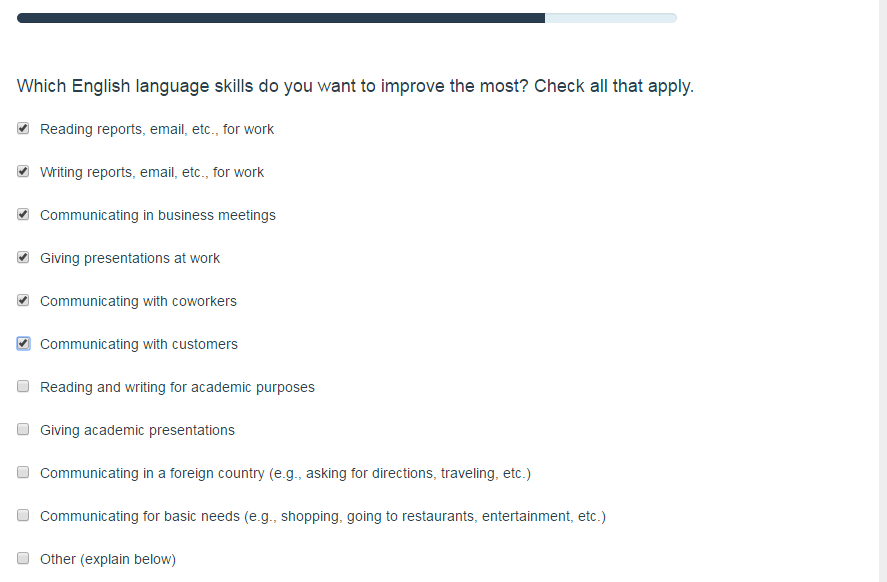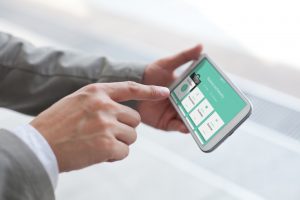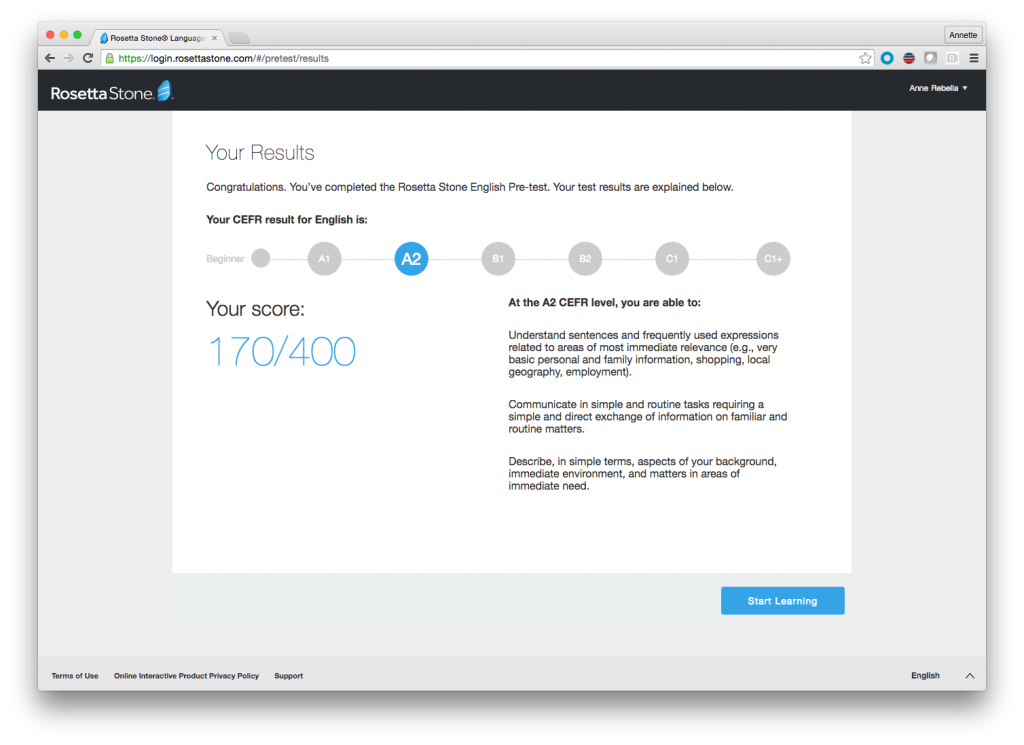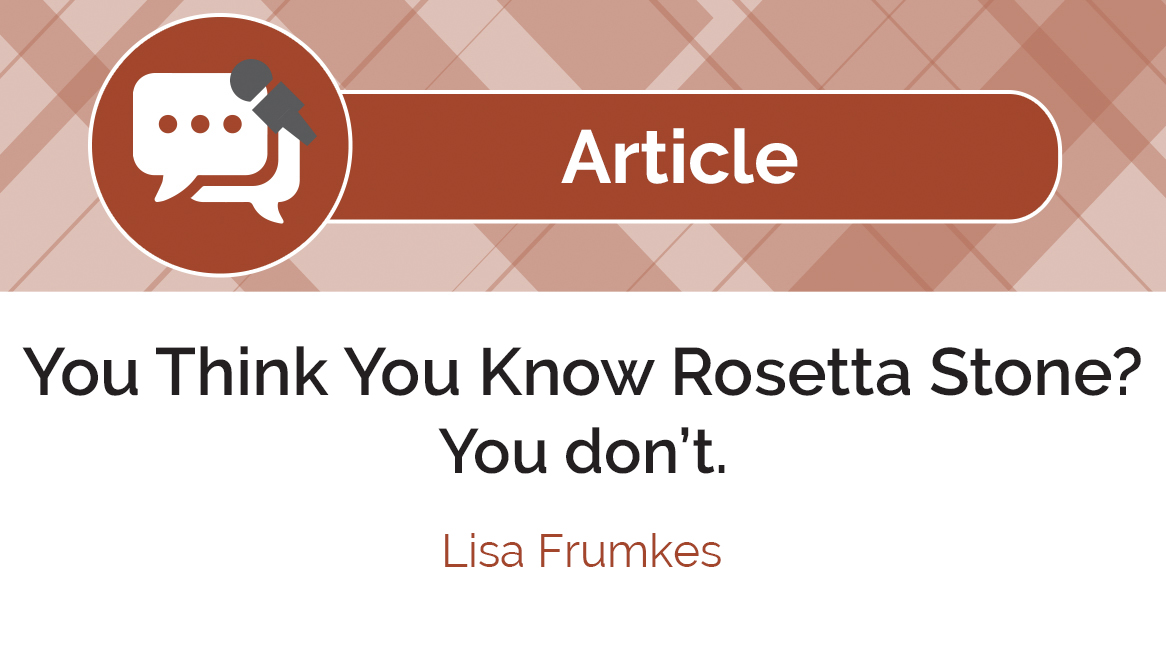You Think You Know Rosetta Stone? You Don’t.
 By Lisa Frumkes, PhD, Senior Director for Content Development at Rosetta Stone.
By Lisa Frumkes, PhD, Senior Director for Content Development at Rosetta Stone.
DOI: https://www.doi.org/10.69732/ENBW8374
You may think you know what Rosetta Stone is all about: what products we provide and how we teach. You may be so sure that you know Rosetta Stone that you’re going to skip this article altogether! But there are a lot of misperceptions floating around out there, based on outdated information. A big part of my job as Senior Director of Content Development at Rosetta Stone is to clear up these misunderstandings and make sure that we build products that help people of all ages, around the world, to learn a language.
I’ve been at Rosetta Stone for less than five years myself. When I joined the company in 2013, I wasn’t clear on all the details either. Obviously, I knew how well received Rosetta Stone was among consumers, and that people saw it as the way to learn a language online, but I didn’t know the details behind how the product was made or how decisions were made regarding what to teach and how to teach it.
When I joined the company, I’d been making my living in Computer-Assisted Language Learning (CALL) for almost 25 years. (1989 was the year I learned to use HyperCard. Along with a Russian professor at Pomona College, I created stacks to teach Russian declension and conjugation.) By 1996, I had earned my PhD in Slavic Linguistics from the University of Washington, and I was supporting small-liberal-arts-college faculty at Connecticut College, Trinity College, and Wesleyan University. My boss, Nina Garrett, had stocked software-development labs at each of the schools, and it was at Wesleyan in 1997 that I explored Rosetta Stone for the first time.
My opinion of Rosetta Stone at that point? Honestly, it was the prettiest and most beautifully executed set of flashcards I’d ever seen! But on the surface, it didn’t seem much more than that. It didn’t feel very challenging to me, either, and at that point I was more interested in trying to figure out how to make software give the impression that it was using artificial-intelligence-type smarts to provide learners with feedback on their written input. So after a couple hours with the product, I set it aside.
Seven years later, in 2003, I got a copy of Rosetta Stone, put my young son on my lap, and started to study Dutch. I had the notion that this might be an interesting way for my baby and me to learn together.
While the familiar set of four images arranged in a two-by-two grid looked familiar, the program had definitely changed. These were no longer flashcards. There was voice recognition. The exercise types were more sophisticated and varied. I was starting to get a sense of how the software taught grammar inductively. But my kid wasn’t cooperative—he kept on hitting random keys on the keyboard, which frustrated me. So that was the end of the experiment.
Another seven years went by. In 2010, I was working at a company that provided online learning to high school students, and was doing an informal survey of language learning products. I looked at Auralog / Tell Me More, and I was pretty impressed. As someone who had studied both French and German in U.S. high schools, Tell Me More looked familiar, and therefore made sense to me. The vocabulary lists and the grammar explanations looked like the materials I’d used in school. I liked the conversations that were presented, and I appreciated the variety of exercises that followed them. Tell Me More offered a nice variety of languages and levels, but didn’t try to teach everything to everyone.
Even though it had been seven years, I didn’t look at Rosetta Stone in 2010. After all, I’d seen folks at conferences at CALICO talk about Rosetta Stone. I figured I knew what it was like.
Three years later, in 2013, I was interviewing to join the team at Livemocha, a Seattle-based language startup that focused on social language-learning. But a funny thing happened—Livemocha was acquired by Rosetta Stone, and suddenly I was working for the company whose software I’d been observing from afar for so long. And then a few months later, towards the end of 2013, Rosetta Stone acquired Tell Me More. So now I had the opportunity to get to know both of these products a whole lot better.
As a new Rosetta Stone employee, I was offered my choice of any Rosetta Stone language. I chose Korean and received one of the iconic yellow boxes in the mail.
I quickly realized what a mistake I’d made when I’d failed to look at Rosetta Stone in 2010. The days of Rosetta Stone being the prettiest flashcards I’d ever seen were long gone, despite the fact that the interface often showed that familiar, two-by-two arrangement of images.
The first unit of study was challenging and got me speaking whole sentences within minutes. The speech recognition was much better than any other language-learning software I’d encountered before. Better yet, because the visual representations of my speech were tucked away, accessible only if I wanted to see them, I no longer felt bad that I couldn’t make my images match what the natives produced. Instead, when my pronunciation was good enough, the program turned an indicator some shade between yellow and green (the greener, the better!) and moved on to the next piece of content. If I didn’t speak well enough, the indicator turned a shade of orange or red, and I had the opportunity to try again. My memories of clicking on various words and images of loudspeakers faded quickly. A good portion of the program was now voice driven.
I have now been at Rosetta Stone for nearly five years, familiarizing myself with the various solutions that we provide. I have spent many hours with beginning Mandarin Chinese, intermediate German, and advanced French.
I have also witnessed first-hand the care with which the content creators have crafted the products. When I joined the company, I inherited an experienced and talented team of language teachers, linguists, cognitive scientists, and other specialists—and we’ve brought in other experts to work with us when we didn’t have the right skills in house.
More than a few of the people on my team have been with the company ten, fifteen or even twenty years. Between the fifteen of us who are full-time, regular employees, we’ve taught, seriously studied, or dabbled in over three dozen languages. My colleagues and I are truly dedicated to the company, to delivering the best product we can, and are constantly looking for ways to make it better. And our efforts show it: Rosetta Stone has evolved from the original flagship yellow-box CD product to the Software as a Service (SaaS) program of today. As times, learners’ expectations, and learning methods have changed, so has Rosetta Stone.
I’ve come to appreciate and admire all the work that has gone into software and content development, and how cleverly and artistically it was executed. My team has demonstrated to me in detail how the product teaches lexicon and grammar inductively–by letting learners figure out how the language works without presenting vocabulary lists or grammar rules. Sometimes, the teaching is so subtle that even an experienced teacher or seasoned linguist might not immediately see what’s going on. The teaching is there, camouflaged by high quality audio, video, and other technology.
There have been lots of changes at Rosetta Stone since I joined in 2013. My Content Development team, which includes researchers and assessment specialists as well as content creators, is now spread across the United States, unlike in the past, when virtually the entire team sat in the Harrisonburg, Virginia office. We hire subject matter experts and speakers of other languages any time we need their expertise, to ensure that we have the right people working on every project. Our small-but-mighty research team is currently conducting controlled and correlational studies with consumers as well as with our education and enterprise clients. By testing our learners before they begin using our solutions, following their progress through the materials, and assessing their progress later, we are able to help our learners appreciate how far they’ve come, while proving the effectiveness of our products.

Our airport kiosks are long gone, but you may still see our new retail products in other airport shops or in the mall. Having said that, many people now buy Rosetta Stone online; subscriptions are a swiftly growing part of our business. Many people also use the materials on mobile devices instead of on laptops or desktops—or they move between the two as they find convenient.
 |
 |
Picture 2 – Users can now move from using course materials on a desktop or laptop to learning on a mobile device–and back again!
Before joining Rosetta Stone, I worked for a company that developed content for online use by high school students. One of the toughest parts of that job was ensuring that the materials we made were aligned with standards like the Common Core. When I joined Rosetta Stone, I was sure those days of poring over standards were behind me. I didn’t realize that Rosetta Stone sold to schools and businesses, not just directly to consumers. In other words, I haven’t escaped the rigors of making content that adheres to standards. Whenever we start working on a new product, we begin with the standards that are most appropriate for the audience we’re addressing—which might be the American Council on the Teaching of Foreign Languages (ACTFL) standards, or state standards for U.S. education, but could be the Common European Framework for Languages (CEFR) when we’re developing content for use in Europe and beyond.
In addition, we offer different materials and services to our various clients in the consumer, corporate, and education sectors. For some years now, we have been adding assessments, such as placement and progress tests, to both our education and enterprise products. Administrators in education and business environments can see how well their learners are doing and whether they are using the materials regularly or not, how much time they’re spending, and how well they’re doing…and then act accordingly.

We also provide K-12 educators with materials that they can print and use with their students in class or as homework. These materials augment and supplement the e-learning materials, which makes using Rosetta Stone easier to use and quite appropriate for use in a blended learning environment. The materials include workbooks, quizzes, picture cards, reading and writing assignments, teacher guides (including grammar explanations and vocabulary lists), and other materials, many of them created specifically for learners of various ages and ability levels. These materials are important for ensuring that our offerings meet standards such as WIDA and the Common Core. My team is currently working with others in the company to make sure that these materials are as accessible and as widely-used as possible by the audiences for whom they were created.
But let’s not forget about the importance of face-to-face practice in the learner’s new language. I always thought of Rosetta Stone as a product that people used in isolation—sitting at home, alone, in front of their computers. I was initially surprised to learn that the company employs literally hundreds of native speakers of the languages we teach. These native speakers provide synchronous (or real time) one-on-one and group instruction to our learners, online. I’ve attended these sessions myself (primarily in my efforts to learn Mandarin Chinese), and have been impressed at how well these language coaches get you speaking and using the material you’ve been studying online—without putting you on the spot or making you feel stupid. They can see where you are in the program and work with you accordingly.
If you’re wondering what happened to the Tell Me More materials that I liked so much and that were acquired by Rosetta Stone, rest assured that they’re still around. We’ve now incorporated them into our offerings for intermediate and advanced learners.
Another recent development is this: in 2014, Rosetta Stone decided to delve deeper into learning and also acquired literacy company Lexia Learning. If you work with beginning readers in elementary grades, you may have encountered Lexia’s excellent, research-backed solution, which has been teaching kids to read for 30 years. My Content Development team and I regularly communicate and share ideas with our Lexia colleagues, as language and literacy education can inform each other in many ways.
My team also loves to work on specialized products. One of the most rewarding projects we’ve worked on over the past few years has been the development of our Advanced Spanish for Healthcare program, which is intended to improve medical outcomes for Spanish-speaking patients. For this project, we worked with a major healthcare provider to develop custom content specifically addressing the healthcare field in order to better aid healthcare professionals, such as doctors and nurses, in preventing miscommunication while better serving their patients.
When people ask me where I work, it is a lot of fun to answer “Rosetta Stone” and to see the gleam of recognition in the eyes of the questioner. Honestly, I never expected to work for a company that is a household name. But it has been, and continues to be, a rewarding and worthwhile experience. I learn something new about our past every day, and I look forward to seeing what’s in store for us in the future.

